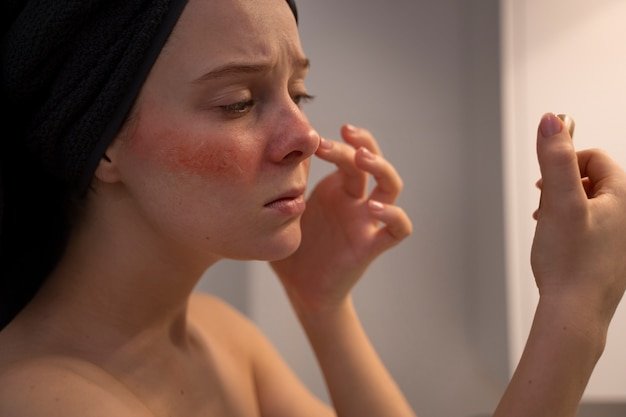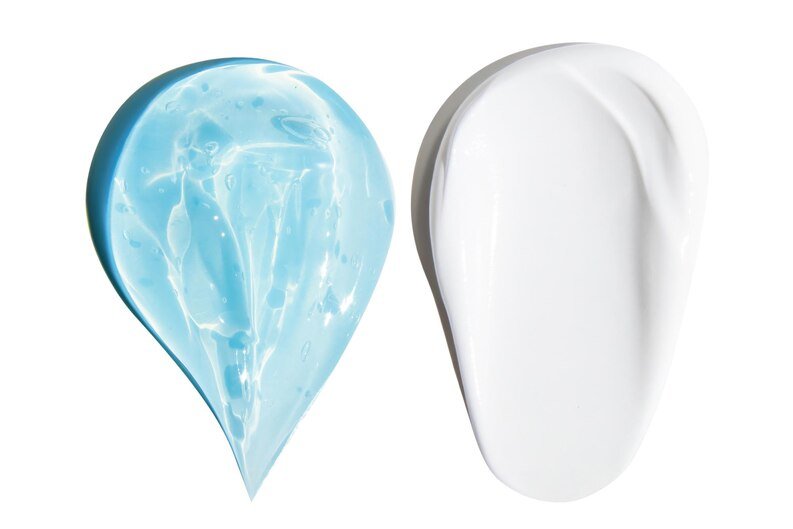Let’s have a look at the differences between Tretinoin Gel vs Cream. Tretinoin gel is lightweight, ideal for oily skin; cream is emollient, better for dry or sensitive skin. Gel absorbs quickly, while cream offers more moisturization.
If you’re looking to address skin issues like acne, aging, fine lines, or uneven skin tone, you’ve likely come across this popular skincare ingredient. Tretinoin, a derivative of vitamin A, is renowned for its effectiveness in improving skin texture and appearance. However, when it comes to using tretinoin, one of the key decisions you’ll face is choosing between tretinoin gel and tretinoin cream. In this article, we’ll delve into the differences between these two formulations and help you make an informed choice for your skincare routine.
Understanding Tretinoin
Tretinoin, often referred to as a retinoid, is available in various formulations. Tretinoin gel and tretinoin cream are two popular options that are used to address different skin types and concerns. While they both contain the active ingredient tretinoin, their consistency and absorption rates differ significantly.
Tretinoin Gel: Advantages and Application
Tretinoin gel is known for its lightweight texture that is quickly absorbed into the skin. It is suitable for individuals with oily or acne-prone skin, as it tends to be less emollient and less likely to clog pores. The gel formulation is especially beneficial for those who prefer a non-greasy feel on their skin. Applying tretinoin gel is relatively straightforward – a small amount is usually applied to the affected areas of the skin after cleansing and drying. Due to its rapid absorption, it’s important to work quickly and ensure even distribution.
Tretinoin Cream: Benefits and Usage
Tretinoin cream, on the other hand, has a richer texture and is better suited for individuals with dry or sensitive skin. The cream formulation provides added moisturization and can help mitigate potential irritation, making it a favorable choice for those who are prone to dryness or discomfort when using skincare products. It’s important to note that using tretinoin cream may require a more gradual introduction to avoid excessive dryness or redness, especially for those new to retinoid treatments.
Tretinoin Gel vs Cream: How they Work?

Tretinoin Gel
Tretinoin gel is a topical medication formulated with the active ingredient tretinoin, which is a type of retinoid. Retinoids are derivatives of vitamin A and are known for their ability to influence cell turnover and collagen production in the skin. Tretinoin, in particular, works by binding to specific receptors in skin cells, influencing their behavior and functions.
When tretinoin gel is applied to the skin, it penetrates the outermost layer, known as the epidermis. Once absorbed, it travels deeper into the skin to reach the dermis, where collagen and elastin fibers are located. Tretinoin stimulates the turnover of skin cells, prompting old and damaged cells to shed more rapidly. This process, known as exfoliation, reveals fresher, healthier cells beneath, leading to a smoother and more radiant complexion.
Additionally, tretinoin gel helps unclog pores by preventing the formation of comedones and reducing the production of sebum, the skin’s natural oil. By regulating sebum production and promoting exfoliation, tretinoin gel is effective in treating acne and preventing new breakouts. Its water-based formulation allows it to be quickly absorbed into the skin, making it suitable for those with oily or acne-prone skin.
Tretinoin Cream
Similar to tretinoin gel, tretinoin cream also contains the active ingredient tretinoin, which belongs to the retinoid family. However, the cream formulation is designed to have a thicker, more emollient texture, making it beneficial for individuals with drier or more sensitive skin.
When tretinoin cream is applied, it follows a similar pathway as the gel. It first penetrates the epidermis and then reaches the dermis, where it exerts its effects on skin cell turnover and collagen production. However, due to its creamier consistency, tretinoin cream tends to provide more moisturization to the skin. This can be particularly helpful for individuals with dry skin, as it helps counteract the potential dryness and irritation that can be associated with tretinoin treatment.
The cream formulation is well-suited for those who experience sensitivity to retinoids and require a gentler approach to incorporating tretinoin into their skincare routine. Its moisturizing properties can help minimize the occurrence of dryness, redness, and flaking that may occur with retinoid use.
Tretinoin Gel vs Cream: Comparing Absorption Rates

One of the key differences between tretinoin gel and cream lies in their absorption rates. Tretinoin gel is water-based and is absorbed more quickly into the skin, making it an ideal choice for those who prefer a lightweight feel and minimal residue. Tretinoin cream, due to its thicker consistency, may take slightly longer to be fully absorbed. This difference can affect how these formulations interact with other products you may apply as part of your skincare routine.
Tretinoin Gel vs Cream: Potential Side Effects

Both tretinoin gel and cream can lead to similar side effects. These side effects are usually temporary and can be managed by adjusting the frequency of application and using a gentle skincare routine. It’s important to note that regardless of the formulation you choose, it’s advisable to start with a lower concentration of tretinoin and gradually increase as your skin becomes accustomed to the treatment.
Tretinoin Gel
- Initial Dryness and Peeling: When starting tretinoin gel, many individuals experience initial dryness, flakiness, and peeling of the skin. This is a common reaction as the medication works to promote skin cell turnover.
- Increased Sensitivity: Tretinoin gel can make the skin more sensitive to external factors such as sunlight and harsh skincare products. It’s crucial to use sunscreen and avoid excessive sun exposure to prevent sunburn and skin damage.
- Redness and Irritation: Some people may experience redness, mild irritation, and a sensation of warmth upon application of tretinoin gel. This usually subsides as the skin becomes accustomed to the treatment.
- Exacerbation of Acne: In the initial stages of using tretinoin gel, some individuals might notice a temporary worsening of acne breakouts. This is often referred to as the “purge” phase and is a result of deep-seated impurities surfacing.
- Dryness Around Eyes and Mouth: Tretinoin gel can sometimes lead to dryness and sensitivity around delicate areas like the eyes and mouth. Applying a gentle moisturizer can help alleviate this.
Tretinoin Cream
- Dryness and Flaking: Like tretinoin gel, tretinoin cream can also cause dryness and flaking, especially in the early stages of use. This is a normal part of the skin’s adjustment to the medication.
- Sensitivity to Sunlight: Tretinoin cream can increase the skin’s sensitivity to the sun, making it more prone to sunburn. Wearing sunscreen and protective clothing is essential when using this formulation.
- Stinging and Burning Sensation: Some individuals might experience a mild stinging or burning sensation upon application of tretinoin cream. This is usually temporary and tends to diminish with continued use.
- Potential for Irritation: Due to its richer texture, tretinoin cream might have a higher potential to cause irritation in individuals with sensitive skin. Starting with a lower concentration and gradually increasing frequency can help reduce this risk.
- Risk of Allergic Reactions: While rare, allergic reactions to tretinoin cream can occur. These reactions might manifest as severe redness, itching, swelling, or a rash. Discontinue use and consult a dermatologist if any allergic symptoms arise.
It’s important to note that these side effects are typically transient and tend to subside as the skin adjusts to the medication.
Tretinoin Gel vs Cream: Factors Influencing Choice
The choice between tretinoin gel and cream depends on several factors, including skin type, specific skin concerns, and personal preferences. Individuals with oily skin might lean towards tretinoin gel, as it offers a lighter texture and faster absorption. On the other hand, those with dry or sensitive skin may find tretinoin cream more comfortable due to its added moisturization benefits. It’s essential to consider how your skin reacts to different products and adjust your choice accordingly.
Tretinoin Gel vs Cream: Tips for Incorporating Tretinoin
Regardless of the formulation you choose, it’s important to start with a lower concentration and gradually increase as your skin becomes accustomed to the treatment. Applying tretinoin at night, following cleansing and before moisturizing, is generally recommended. This allows the active ingredient to work overnight without the potential interference of other products. Remember that consistency is key – visible improvements in skin texture and tone often require several weeks to become noticeable.
Combining Tretinoin with Other Products
When using tretinoin, it’s crucial to avoid certain products that can interact negatively with the treatment. Harsh exfoliants and products containing benzoyl peroxide should be used with caution or as directed by a dermatologist. It’s advisable to simplify your skincare routine while using tretinoin and introduce new products gradually to prevent overloading your skin with too many active ingredients.
Tretinoin Gel vs Cream: The Importance of Patch Testing
Before incorporating tretinoin into your routine, performing a patch test is advisable. This involves applying a small amount of the product to a small area of skin to check for any adverse reactions. Patch testing can help you identify potential sensitivities and reduce the risk of experiencing widespread irritation.
Tretinoin Gel vs Cream: Pros and Cons

Tretinoin Gel
Pros
- Quick Absorption: Tretinoin gel has a lightweight texture that is quickly absorbed into the skin, making it suitable for individuals who prefer a non-greasy feel.
- Ideal for Oily Skin: The gel formulation is well-suited for individuals with oily or acne-prone skin, as it is less emollient and less likely to clog pores.
- Less Residue: Tretinoin gel leaves minimal residue on the skin, making it convenient for daytime use or under makeup.
- Reduced Risk of Breakouts: The water-based formula of tretinoin gel helps regulate sebum production, reducing the risk of new acne breakouts.
- Faster Results: Due to its rapid absorption, tretinoin gel may lead to quicker visible improvements in skin texture and appearance.
Cons
- Higher Irritation Potential: The quick absorption of tretinoin gel can also lead to a higher risk of irritation, especially for those with sensitive skin.
- Less Moisturization: The lightweight nature of the gel may not provide as much moisturization as needed for individuals with dry skin.
Tretinoin Cream
Pros
- Moisturizing Properties: Tretinoin cream has a richer texture that offers added moisturization, making it suitable for individuals with dry or sensitive skin.
- Gentler on Skin: The cream formulation tends to be gentler on the skin and may cause less initial dryness and irritation compared to the gel.
- Suitable for Sensitive Skin: Individuals with sensitive skin may find tretinoin cream more comfortable and less likely to cause immediate redness or discomfort.
- Reduced Risk of Over-Drying: The emollient properties of the cream help prevent excessive dryness and flaking, which can be a concern with retinoid use.
Cons
- Slower Absorption: Tretinoin cream has a thicker consistency, which means it takes longer to be fully absorbed into the skin compared to the gel.
- Potentially More Residue: The cream formulation can leave a thicker residue on the skin, which might not be preferred for daytime use or under makeup.
- May Clog Pores: Individuals with oily or acne-prone skin may find that the cream formulation is more likely to clog pores, leading to potential breakouts.
- Delayed Results: Due to its slower absorption, tretinoin cream may take slightly longer to show visible improvements in skin texture and appearance.
Consulting a Dermatologist
For personalized guidance on choosing between tretinoin gel and cream, it’s recommended to consult a dermatologist. A dermatologist can assess your skin’s needs, medical history, and any ongoing skincare treatments to recommend the most suitable formulation for your specific concerns. They can also provide insights into how to incorporate tretinoin into your existing skincare routine without causing any disruptions.
Tretinoin Gel vs Cream: Brief Comparison Table
| Aspect | Tretinoin Cream | Tretinoin Gel |
| Consistency | Creamier texture with emollient properties | Lightweight texture, water-based formulation |
| Skin Type | Dry or sensitive skin | Oily or acne-prone skin |
| Absorption Rate | Slower absorption, takes more time to absorb | Quick absorption, rapidly absorbed |
| Residue | Thicker residue on the skin | Minimal residue, suitable for daytime use |
| Moisturization | Provides added moisturization | Offers less moisturization |
| Irritation Potential | Lower potential for irritation, gentler on skin | Higher potential for irritation |
| Acne-Prone Skin | May clog pores for oily skin | Less likely to clog pores |
| Visible Results | Takes slightly longer for visible improvements | May lead to faster visible improvements |
| Concentration Options | Various concentrations available | Various concentrations available |
| Suitable For | Dry, sensitive, or those prone to irritation | Oily, acne-prone, or those seeking quick results |
| Usage and Recommendations | Gradual introduction to prevent dryness | Quick and even application recommended |
| Recommended Use | Typically for nighttime use | Can be used day or night |
Tretinoin Gel vs Cream: Final Verdict
In conclusion, the choice between tretinoin gel and cream is a decision that should be made based on your individual skin type, concerns, and preferences. Both formulations contain the active ingredient tretinoin, which is effective in promoting skin cell turnover, improving texture, and addressing various skin issues such as acne and fine lines. Tretinoin gel is well-suited for those with oily or acne-prone skin, offering quick absorption and a lightweight feel.
On the other hand, tretinoin cream provides added moisturization, making it a better choice for individuals with dry or sensitive skin. Whichever formulation you choose, it’s essential to start with a lower concentration, introduce the product gradually, and consult a dermatologist for personalized recommendations to ensure the best results while minimizing potential side effects. Remember that consistency, patience, and professional guidance are key to achieving your desired skincare goals.
[youtube https://www.youtube.com/watch?v=47zxph9mFmU&w=560&h=315]FAQs
Is tretinoin gel or cream better?
The choice between tretinoin gel and cream depends on your skin type and preferences. Tretinoin gel is ideal for oily or acne-prone skin due to its quick absorption and lightweight texture. On the other hand, tretinoin cream is better suited for individuals with dry or sensitive skin, as it provides added moisturization and is less likely to cause immediate irritation. Consult a dermatologist to determine which formulation aligns with your skincare needs.
What is the strongest form of tretinoin cream?
The strongest form of tretinoin cream is usually in higher concentrations, such as 0.1%. Higher concentrations may be prescribed by a dermatologist for specific skin concerns; however, they also come with an increased risk of irritation. It’s important to start with a lower concentration and gradually work your way up under the guidance of a healthcare professional.
Is tretinoin gel effective?
Yes, tretinoin gel is effective in addressing various skin concerns, including acne, fine lines, and uneven texture. Its active ingredient, tretinoin, works by promoting cell turnover and collagen production, leading to improved skin texture and appearance over time.
Is tretinoin gel the same as Retin-A?
Tretinoin gel and Retin-A are not exactly the same, but they both contain the active ingredient tretinoin. Retin-A is a brand name for tretinoin, while tretinoin gel is a generic formulation that also contains tretinoin. Both can be effective, but formulations and concentrations may vary.
Which is more effective, gel or cream?
Both gel and cream formulations of tretinoin are effective; the choice depends on your skin type and concerns. Gel may work well for oily skin, while cream is better for dry or sensitive skin. The effectiveness of each formulation is determined by the active ingredient, tretinoin, which stimulates cell turnover and collagen production.
Can I use tretinoin gel every night?
Using tretinoin gel every night can be effective, but it may increase the risk of irritation, especially for those with sensitive skin. It’s advisable to start with every other night and gradually increase frequency as your skin adjusts. Consult a dermatologist to create a personalized regimen that suits your skin’s tolerance.
Is 0.05 stronger than 0.025 tretinoin?
Yes, 0.05% tretinoin is stronger than 0.025%. Higher concentrations are usually prescribed for more advanced skin concerns, but they also come with an increased likelihood of side effects. Starting with a lower concentration and progressing slowly is recommended to minimize irritation.
How can I make tretinoin more effective?
To enhance the effectiveness of tretinoin, follow these tips: start with a lower concentration, introduce it gradually, use sunscreen daily, moisturize regularly, avoid harsh exfoliants, and consult a dermatologist for personalized guidance.
What is tretinoin gel 0.01 used for?
Tretinoin gel 0.01% is a topical treatment used to address various skin concerns, including acne, fine lines, and uneven skin texture. It contains tretinoin, which helps promote skin cell turnover and collagen production for improved skin appearance.
Is retinol cream or gel better?
Both retinol cream and tretinoin gel have their benefits. Retinol is a milder form of vitamin A that is available over the counter, while tretinoin is a prescription-strength derivative. Tretinoin gel tends to be more potent and effective, but it also comes with a higher risk of irritation. Consult a dermatologist to determine which is best for your skin.
When should I stop using tretinoin gel?
The duration of tretinoin gel use varies based on individual goals and skin concerns. Some people use it indefinitely for maintenance, while others may take breaks. It’s important to consult a dermatologist for personalized recommendations on when to stop or adjust tretinoin use.
How fast does tretinoin gel work?
Tretinoin gel’s effects vary by individual and concern. Some users notice improvements in skin texture and appearance within a few weeks, while others may take a few months to see noticeable changes. Consistency and patience are key to achieving optimal results.
Is tretinoin gel good for wrinkles?
Yes, tretinoin gel can be effective for reducing the appearance of fine lines and wrinkles. It promotes collagen production and skin cell turnover, which can lead to smoother, more youthful-looking skin over time.
Why use tretinoin gel?
Tretinoin gel is used to address various skincare concerns, including acne, fine lines, and uneven skin texture. Its active ingredient, tretinoin, promotes healthier skin by encouraging cell turnover and collagen production.
What strength of tretinoin cream is best for wrinkles?
A dermatologist can recommend the appropriate strength of tretinoin cream for wrinkles based on your skin type and concerns. Generally, higher concentrations (e.g., 0.05% or 0.1%) are effective for addressing fine lines and wrinkles, but starting with a lower concentration is advisable to minimize irritation.
References
- Baumann, L. (2019). Cosmeceuticals and Cosmetic Ingredients. McGraw-Hill Education.
- Mukherjee, S., Date, A., Patravale, V., Korting, H. C., Roeder, A., & Weindl, G. (2006). Retinoids in the treatment of skin aging: an overview of clinical efficacy and safety. Clinical Interventions in Aging, 1(4), 327–348.
- Rawlings, A. V. (2003). Trends in stratum corneum research and the management of dry skin conditions. International Journal of Cosmetic Science, 25(1-2), 63–95.
- Tanghetti, E. A., Del Rosso, J. Q., Thiboutot, D., Ditre, C. M., & Zaenglein, A. L. (2012). Consensus recommendations on the use of topical tretinoin (retinoid) in the management of acne. Journal of Clinical and Aesthetic Dermatology, 5(8 Suppl), S1–S12.

